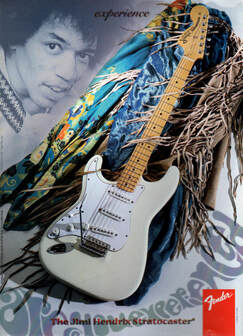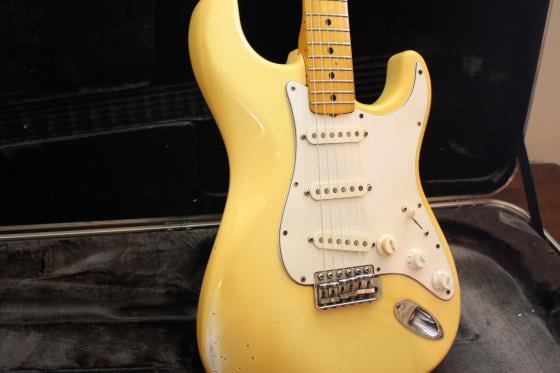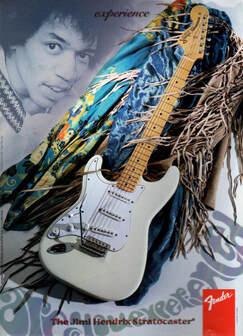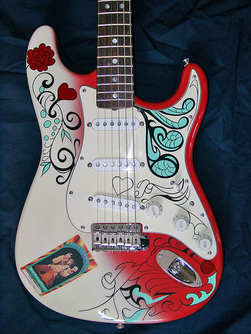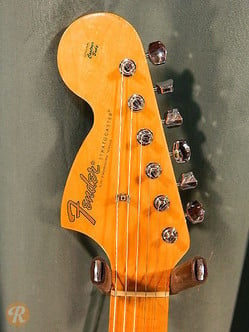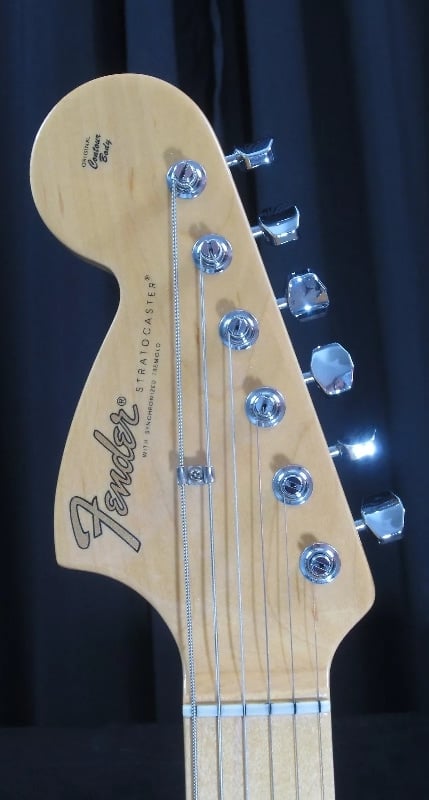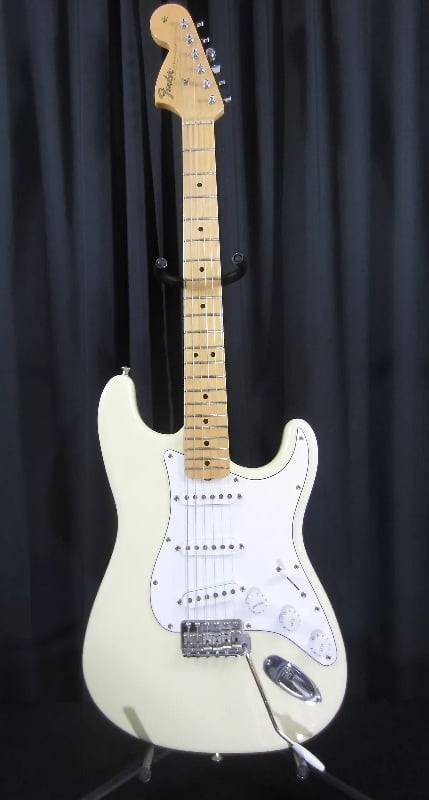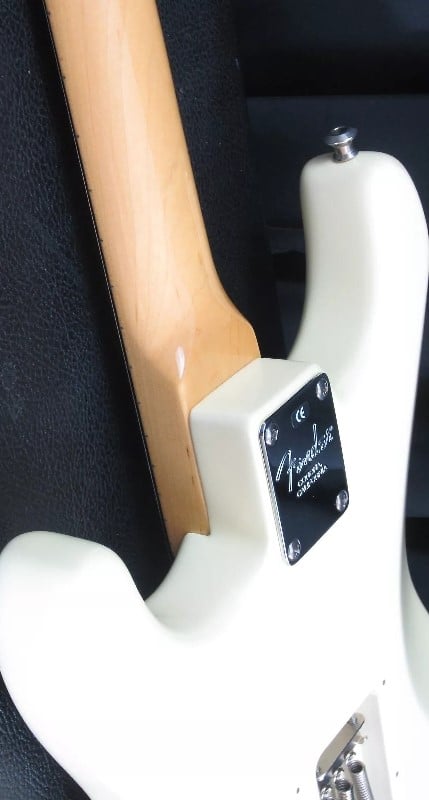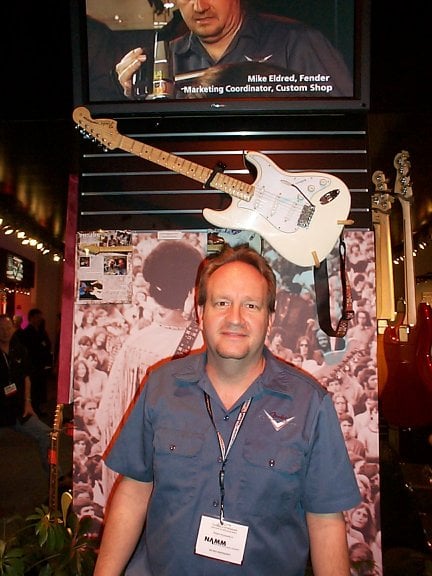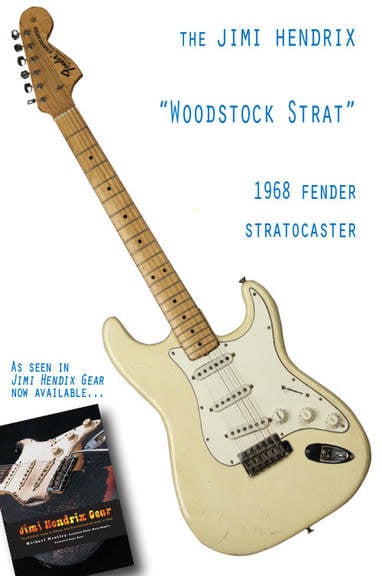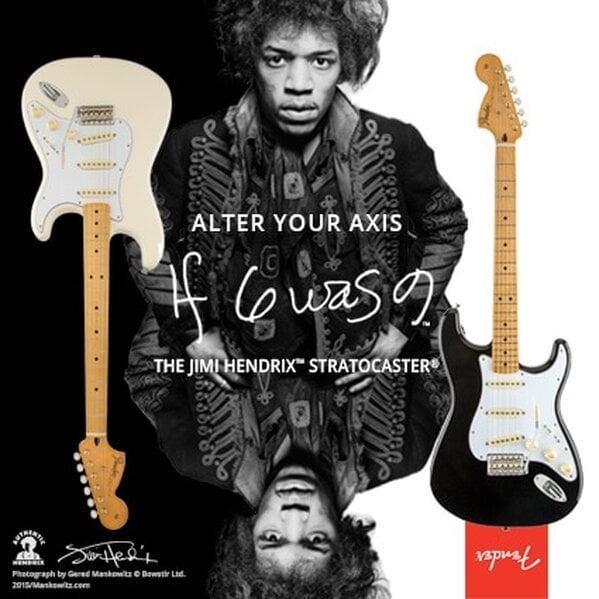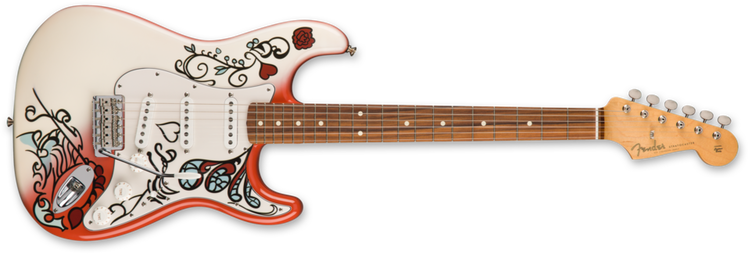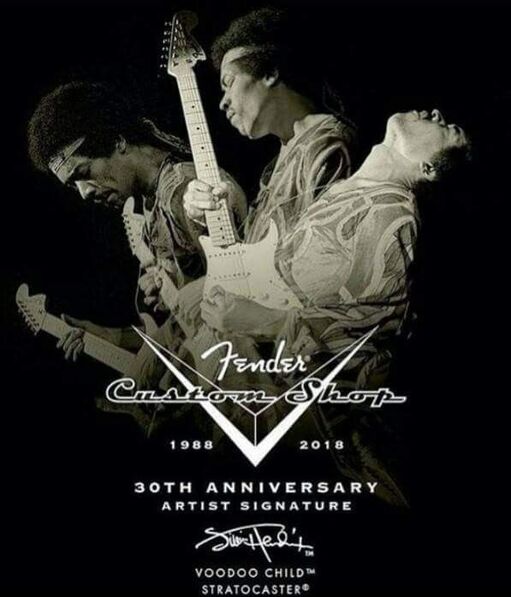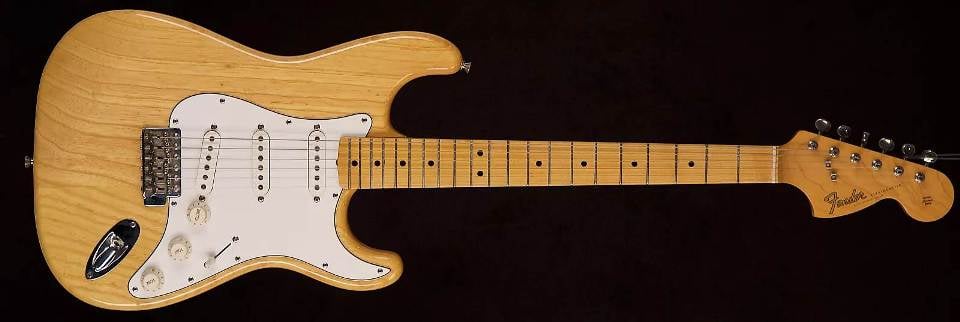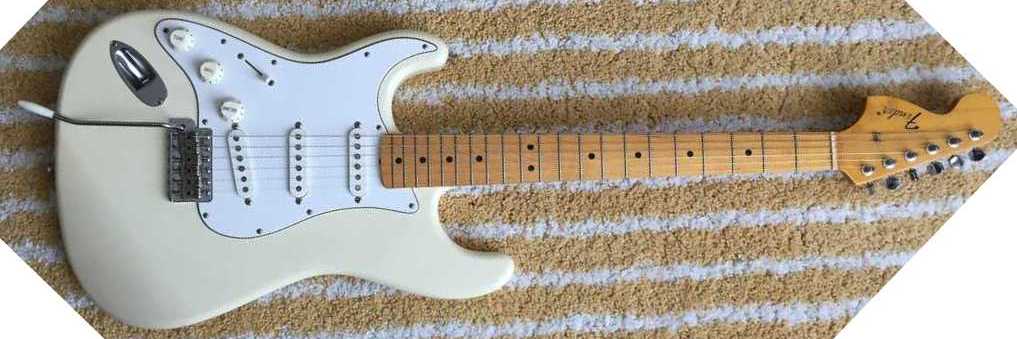Of all the guitarists who made the Stratocaster the essential instrument of their music, certainly Jimi Hendrix has been the one that most influenced the history of rock and the fate of the Fender. In a period in which this guitar was not at its best, the Seattle musician has been able to bring guitarists from all over the world closer to the Stratocaster. It is not a surprise, then, that Fender wanted to pay homage to Hendrix with a series of guitars dedicated to him.
Apart from the 1980 Hendrix Stratocaster, which was developed in the Research & Development department of Fender years before the birth of the Signature Series and of the Custom Shop, the other guitars dedicated to Jimi Hendrix were the Custom Shop tribute Stratocasters, or those belonging to the Special Series or to the Collectibles Series. The only ones that, strangely, were counted among the Artist Series were the 1997 Jimi Hendrix Tribute Stratocaster, and the 2015 Jimi Hendrix Stratocaster and 2017 Monterey Stratocaster, both of which were made in Mexico
Apart from the 1980 Hendrix Stratocaster, which was developed in the Research & Development department of Fender years before the birth of the Signature Series and of the Custom Shop, the other guitars dedicated to Jimi Hendrix were the Custom Shop tribute Stratocasters, or those belonging to the Special Series or to the Collectibles Series. The only ones that, strangely, were counted among the Artist Series were the 1997 Jimi Hendrix Tribute Stratocaster, and the 2015 Jimi Hendrix Stratocaster and 2017 Monterey Stratocaster, both of which were made in Mexico
1980 HENDRIX STRATOCASTER
In 1980 about 25 units of the Hendrix Stratocaster were made. This guitar had nothing to do with the other Fenders dedicated to the African American myth, which were produced later. Available only in the Olympic White finish, it was basically similar to the other Stratocasters of the period, but featured an additional front contour and a large reverse headstock, that modified the relative length of the strings, creating a different tension and simplifying the bendings on the treble E and B strings, because the shorter the side of the string between the nut and the key, the less force would be needed to pull it.
The Hendrix Stratocaster was pushed by Mudge Miller, then VP Sales and Marketing at Fender, and was made in the R&D (research and development) department of Fender. John Page did most of the work: he remembers that Miller initially wanted an additional decal, which actually was never applied, on the headstock, a circled “M”,for “modified” (or for "Miller"? - the most mischievous suspect).
It seems that only 25 units were fabricated, most likley all or almost all prototypes, of which only five have been certified. One was owned by Stevie Ray Vaughan who sometimes used it in his performances; another by John Mayer which was the one analyzed by Fender Custom Shop for the purpose of making the about a hundred replicas in 2005.
The Hendrix Stratocaster was pushed by Mudge Miller, then VP Sales and Marketing at Fender, and was made in the R&D (research and development) department of Fender. John Page did most of the work: he remembers that Miller initially wanted an additional decal, which actually was never applied, on the headstock, a circled “M”,for “modified” (or for "Miller"? - the most mischievous suspect).
It seems that only 25 units were fabricated, most likley all or almost all prototypes, of which only five have been certified. One was owned by Stevie Ray Vaughan who sometimes used it in his performances; another by John Mayer which was the one analyzed by Fender Custom Shop for the purpose of making the about a hundred replicas in 2005.
|
Stevie Ray Vaughan with the Jimi Hendrix Stratocaster
|
Fender 1967 REISSUE JIMI HENDRIX STRATOCASTER
Made by Custom Shop in 1991, despite the name it was neither designed in collaboration with the Hendrix family, nor could it be considered a reissue. In fact, it did not replicate any particular year, but simply recreated the magic around Jimi Hendrix, thanks to the reverse headstock with Transition Logo. The Olympic White finished body was reminiscent, due to its front contour, of the 1980 Hendrix Stratocaster. According to Scott Grant, 15 units were made, all accompanied by a certificate of authenticity signed by John Page.
HENDRIX TRIBUTE STRATOCASTER, MONTEREY POP, VOODOO
In 1997, thirty years after Jimi Hendrix's debut with Are you Experienced?, Fender launched two guitars dedicated to the musician who most of all contributed to the spread of the Stratocasters: one factory, the other made by Custom Shop.
The first was simply called the Jimi Hendrix Tribute Stratocaster (often known as Jimi Hendrix Stratocaster) and remained in production until 2000. It was basically a left-handed maple cap Stratocaster with big headstock and mirror image decals, reversed and adapted for right-handers (who represented the vast majority of guitarists and therefore a better investment for FMIC). It featured three reverse-staggered, vintage '69, alnico magnet pickups.
The Custom Shop Jimi Hendrix Monterey Pop Stratocaster was, on the contrary, a tribute to the floral Stratocaster to which the guitarist set fire in summer 1967 at the Monterey Pop Festival. Only 210 units were made, all hand painted by Pamelina Hovnatanian, some of which were Diamond Dealer and therefore available only at some selected retailers and recognizable for a Custom Shop Logo with diamond in relief on the headstock.
This guitar wasn't actually a replica, but a tribute. In fact, the Stratocaster that Hendrix burned in Monterey was dated 1964 and it had clay dots and Spaghetti Logo, differently from the Custom Shop model that had the Transition Logo and pearl dots. Also, the appearance did not perfectly replicate the appearance of the guitar used by the African American musician. In fact, Pamelina replaced the pink and yellow daisy on the upper horn with a red rose and colored the swirls near the pickguard differently, eliminating the red.
Another guitar dedicated to Jimi Hendrix in the '90s was the 1998 Voodoo Stratocaster. It sported a reverse headstock with right-handed logo, rosewood fretboard or maple cap, with a body for right-handed players but reverse-angled bridge pickup.
The first was simply called the Jimi Hendrix Tribute Stratocaster (often known as Jimi Hendrix Stratocaster) and remained in production until 2000. It was basically a left-handed maple cap Stratocaster with big headstock and mirror image decals, reversed and adapted for right-handers (who represented the vast majority of guitarists and therefore a better investment for FMIC). It featured three reverse-staggered, vintage '69, alnico magnet pickups.
The Custom Shop Jimi Hendrix Monterey Pop Stratocaster was, on the contrary, a tribute to the floral Stratocaster to which the guitarist set fire in summer 1967 at the Monterey Pop Festival. Only 210 units were made, all hand painted by Pamelina Hovnatanian, some of which were Diamond Dealer and therefore available only at some selected retailers and recognizable for a Custom Shop Logo with diamond in relief on the headstock.
This guitar wasn't actually a replica, but a tribute. In fact, the Stratocaster that Hendrix burned in Monterey was dated 1964 and it had clay dots and Spaghetti Logo, differently from the Custom Shop model that had the Transition Logo and pearl dots. Also, the appearance did not perfectly replicate the appearance of the guitar used by the African American musician. In fact, Pamelina replaced the pink and yellow daisy on the upper horn with a red rose and colored the swirls near the pickguard differently, eliminating the red.
Another guitar dedicated to Jimi Hendrix in the '90s was the 1998 Voodoo Stratocaster. It sported a reverse headstock with right-handed logo, rosewood fretboard or maple cap, with a body for right-handed players but reverse-angled bridge pickup.
Fender '68 REVERSE STRAT SPECIAL
Between 2001 and 2002 it was the turn of the '68 Reverse Strat Special, which took the place of the Voodoo Stratocaster among the tributes to Jimi Hendrix.
Due to the use of the neck plate of the Voodoo Strat, depicting Hendrix's silhouette, there was a legal dispute between Hendrix family and Fender, which stopped producing the guitar and retained the parts already made. A few years later Fender put the advanced stocks back on the market this time avoiding any use of the name or anything which could connect the guitar to Jimi Hendrix, replacing the neck plate Hendrix engraved of the Voodoo with a "Fender CORONA CALIFORNIA" engraved one. The '68 Reverse Strat Special was born.
Different from the Voodoo, which could be had with an optional rosewood fretboard, in ’98 and ’99, the new guitar had only a maple fretboard. Serial numbers started with "TN7", where "N7" stood for "1997", just like those of the Jimi Hendrix Tribute Stratocaster and the Voodoo Stratocaster, even if the Reverse Strat Special had been in production between 2001 and 2002, and “T” probably meant “tribute”, despite not being a “tribute” guitar in the strict sense.
Due to the use of the neck plate of the Voodoo Strat, depicting Hendrix's silhouette, there was a legal dispute between Hendrix family and Fender, which stopped producing the guitar and retained the parts already made. A few years later Fender put the advanced stocks back on the market this time avoiding any use of the name or anything which could connect the guitar to Jimi Hendrix, replacing the neck plate Hendrix engraved of the Voodoo with a "Fender CORONA CALIFORNIA" engraved one. The '68 Reverse Strat Special was born.
Different from the Voodoo, which could be had with an optional rosewood fretboard, in ’98 and ’99, the new guitar had only a maple fretboard. Serial numbers started with "TN7", where "N7" stood for "1997", just like those of the Jimi Hendrix Tribute Stratocaster and the Voodoo Stratocaster, even if the Reverse Strat Special had been in production between 2001 and 2002, and “T” probably meant “tribute”, despite not being a “tribute” guitar in the strict sense.
The '68 Reverse Strat Special was identical with the previous Voodoo Stratocaster, but it had a different neck plate and maple fretboard only
THE JIMI HENDRIX WOODSTOCK STRATOCASTER
To celebrate the 60th birthday of Jimi Hendrix, Mike Eldred started working in 2002 on four clones of the Stratocaster played by the guitarist at Woodstock: the Jimi Hendrix Woodstock Stratocaster, unveiled in 2003.
It was a step of great importance for Fender, because it was the first time that the company spent, in a project, all the resources needed to meticulously reproduce the replicas. In order to make the Woodstock Stratocaster, George Blanda and Mike Eldred went to the Seattle Experience Music Project (EMP),where the original guitar was on permanent display, to analyze and study it. As Mike remembers: “We measured the output of the pickups, the neck shape, everything. In my 24 years in this business, I have never experienced any guitar with that much vibe. It was really intense when they were taking it out of the display! Everyone was just watching, waiting, not saying a word, and they were filming the whole thing. And when they were putting it back, I felt this overwhelming sadness because no one would ever do that again.” And, about how faithful his copies could be to the original, he adds: “These five guitars - the original plus the four clones - are indistinguishable from each other, and I do not say lightly. The colors were correctly aged, and the output of the pickups and the neck dimensions were matched. This is why all that deep research was necessary. Like the separate components on each guitar, a particular part would not only look exactly the same, it would weigh the same!”
The four replicas were distributed in this way: one went to Jamie Hendrix, Jimi’s sister, as a representative of the Seattle guitarist family, one to Paul Allen of the EMP, one to the Fender Museum, and the last was sold at auction at Cooper Owen Auction for $11,000 (given to charity).
It was a step of great importance for Fender, because it was the first time that the company spent, in a project, all the resources needed to meticulously reproduce the replicas. In order to make the Woodstock Stratocaster, George Blanda and Mike Eldred went to the Seattle Experience Music Project (EMP),where the original guitar was on permanent display, to analyze and study it. As Mike remembers: “We measured the output of the pickups, the neck shape, everything. In my 24 years in this business, I have never experienced any guitar with that much vibe. It was really intense when they were taking it out of the display! Everyone was just watching, waiting, not saying a word, and they were filming the whole thing. And when they were putting it back, I felt this overwhelming sadness because no one would ever do that again.” And, about how faithful his copies could be to the original, he adds: “These five guitars - the original plus the four clones - are indistinguishable from each other, and I do not say lightly. The colors were correctly aged, and the output of the pickups and the neck dimensions were matched. This is why all that deep research was necessary. Like the separate components on each guitar, a particular part would not only look exactly the same, it would weigh the same!”
The four replicas were distributed in this way: one went to Jamie Hendrix, Jimi’s sister, as a representative of the Seattle guitarist family, one to Paul Allen of the EMP, one to the Fender Museum, and the last was sold at auction at Cooper Owen Auction for $11,000 (given to charity).
The Reverse Proto Strat
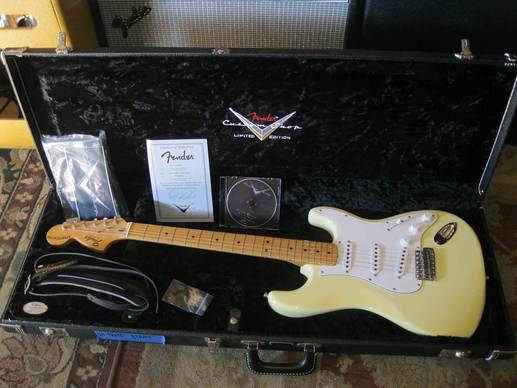 Reverse Proto Strat (courtesy of Reverb)
Reverse Proto Strat (courtesy of Reverb)
The Reverse Proto Strat was a Stratocaster made in 2005 by Master Builder Dennis Galuszka and inspired by 1980 Hendrix Stratocaster. About one hundred units were fabricated in two years, after analyzing one of the original prototypes owned by John Mayer.
The Reverse Proto Strat featured a two-piece alder body in a Closet Classic Vintage White finish, one piece maple neck, “F” tuning machines and CBS style die-cast bridge. The pickups were gray bobbin single-coils and the neck plate had engraved an "F" and a black plastic gasket. The reverse headstock sported "right-side" decals (but it was devoid of the "PROTOTYPE" decal which stood out on the back of the headstock of the 1980 model) and there was, as in the original, an additional front contour on the body.
The Reverse Proto Strat featured a two-piece alder body in a Closet Classic Vintage White finish, one piece maple neck, “F” tuning machines and CBS style die-cast bridge. The pickups were gray bobbin single-coils and the neck plate had engraved an "F" and a black plastic gasket. The reverse headstock sported "right-side" decals (but it was devoid of the "PROTOTYPE" decal which stood out on the back of the headstock of the 1980 model) and there was, as in the original, an additional front contour on the body.
The Jimi Hendrix Stratocaster Made in Mexico
In mid-2015 Fender kept on celebrating its idol with a new guitar, this time a made in Mexico model: the Jimi Hendrix Stratocaster.
It replicated Hendrix's inclination to play upside-down right-handed guitars. In fact, it featured a reverse big headstock and three Pure Vintage ’65 pickups mounted upside down. The bridge pickup also had an inverted inclination, thus generating “warm sound with enhanced upper harmonics and definition on the bass strings while adding girth to the treble strings.”
Finally, the guitar sported the Jimi Hendrix’s signature on the back of the headstock and a neck plate engraved with the effigy of the musician together with the “AUTHENTIC HENDRIX” writing.
It replicated Hendrix's inclination to play upside-down right-handed guitars. In fact, it featured a reverse big headstock and three Pure Vintage ’65 pickups mounted upside down. The bridge pickup also had an inverted inclination, thus generating “warm sound with enhanced upper harmonics and definition on the bass strings while adding girth to the treble strings.”
Finally, the guitar sported the Jimi Hendrix’s signature on the back of the headstock and a neck plate engraved with the effigy of the musician together with the “AUTHENTIC HENDRIX” writing.
MONTEREY STRATOCASTER MADE IN mEXICO
“It’s an honor to celebrate such an iconic musical moment and Jimi Hendrix’s legacy on the eve of the 50th anniversary of the Monterey Pop Festival,” Justin Norvell, Fender Vice President, declared on the occasion of the presentation of the Monterey Stratocaster in 2017. “The Stratocaster was at the heart of countless, iconic Hendrix performances, but Monterey marked his arrival in the United States as a musical force – and Fender is proud to have been a part of that moment. The fiery culmination of Hendrix’s set went down as one of the most iconic images of the 20th century. Although little of the guitar remained afterward, a detailed examination of photos and video from the performance helped us develop our version of the original guitar, down to the detailed nail-polish artistry.”
The instrument, in accordance with the CITES 2017 regulations that limited the use of rosewood, featured a fretboard in Pau Ferro. Different from the previous Custom Shop model, this one exhibited the Spaghetti Logo on the headstock; however, also the new Monterey did not have perfectly identical designs to the Stratocaster that Jimi Hendrix burned at the 1967 festival, nor the correct fret-markers. The vintage-style single coils had staggered poles to balance the output of each string. Like the Hendrix Stratocaster made in Mexico, the Monterey Stratocaster also featured Hendrix’s signature on the back of the headstock and a neck plate engraved with the effigy of the musician together with the “AUTHENTIC HENDRIX” writing.
The instrument, in accordance with the CITES 2017 regulations that limited the use of rosewood, featured a fretboard in Pau Ferro. Different from the previous Custom Shop model, this one exhibited the Spaghetti Logo on the headstock; however, also the new Monterey did not have perfectly identical designs to the Stratocaster that Jimi Hendrix burned at the 1967 festival, nor the correct fret-markers. The vintage-style single coils had staggered poles to balance the output of each string. Like the Hendrix Stratocaster made in Mexico, the Monterey Stratocaster also featured Hendrix’s signature on the back of the headstock and a neck plate engraved with the effigy of the musician together with the “AUTHENTIC HENDRIX” writing.
JIMI HENDRIX VOODOO CHILD SIGNATURE SRATOCASTER
In 2018, in order to celebrate the 30th anniversary of the Custom Shop, Fender unveiled the Jimi Hendrix Voodoo Child Signature Stratocaster, the new jewel of the "dream factory". The instrument was available in Black and Olympic White finishes and in the two different NOS and Journeyman Relic levels of aging.
Distinctive features were the unmistakable reverse big headstock with straight Transition Logo and Custom Shop Hand-Wound '69 single coils, whose reversed pole piece placement created inspiring tones with enhanced upper harmonics and definition. The pickup at the bridge had “reverse” angulation, so as to bring the sound as close as possible to that of the guitarist.
Distinctive features were the unmistakable reverse big headstock with straight Transition Logo and Custom Shop Hand-Wound '69 single coils, whose reversed pole piece placement created inspiring tones with enhanced upper harmonics and definition. The pickup at the bridge had “reverse” angulation, so as to bring the sound as close as possible to that of the guitarist.
JIMI HEDRIX "IZABELLA" STRATOCASTER
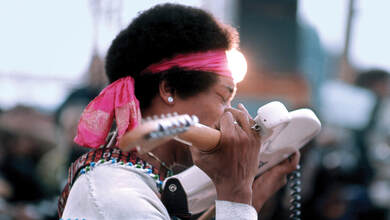 Jimi Hendrix with his "Izabella" at Woodstock
Jimi Hendrix with his "Izabella" at Woodstock
On August 18, 2019, to celebrate the 50th anniversary of Jimi Hendrix's performance at Woodstock, Fender Custom Shop unveiled the Limited Edition Jimi Hendrix Stratocaster, also called "Izabella" Stratocaster.
The guitar is inspired by the famous Olympic White 1968 Stratocaster, which Hendrix named “Izabella” and played during the 1969 musical event, and with which he performed the unforgettable version of the American anthem. “Jimi Hendrix playing Star-Spangled Banner at Woodstock was a cultural moment heard around the world,” Mike Lewis said. We’re especially excited about this release because not only is the Izabella one of the most iconic instruments of our time, it represents a moment in history that will forever be woven in our cultural make-up. The Fender Custom Shop has done tributes to many extremely meaningful artist guitars through the years, but there was an extra sense of awe and privilege in the air in recreating the Izabella.”
The original guitar (serial number "240981") was purchased in 1968 in New York at Manny’s Music, and was later modified to meet the needs of a left-handed guitarist (the movement of the strap lock screw on the lower horn). The replica, limited to 250 copies, went on sale for $6,900. The guitar featured an aged Olympic White finish, a maple cap, big headstock and three Custom Wound ’69 single coils and a hole on the lower horn (reminiscent of the movement of the strap lock in the original model).
The guitar is inspired by the famous Olympic White 1968 Stratocaster, which Hendrix named “Izabella” and played during the 1969 musical event, and with which he performed the unforgettable version of the American anthem. “Jimi Hendrix playing Star-Spangled Banner at Woodstock was a cultural moment heard around the world,” Mike Lewis said. We’re especially excited about this release because not only is the Izabella one of the most iconic instruments of our time, it represents a moment in history that will forever be woven in our cultural make-up. The Fender Custom Shop has done tributes to many extremely meaningful artist guitars through the years, but there was an extra sense of awe and privilege in the air in recreating the Izabella.”
The original guitar (serial number "240981") was purchased in 1968 in New York at Manny’s Music, and was later modified to meet the needs of a left-handed guitarist (the movement of the strap lock screw on the lower horn). The replica, limited to 250 copies, went on sale for $6,900. The guitar featured an aged Olympic White finish, a maple cap, big headstock and three Custom Wound ’69 single coils and a hole on the lower horn (reminiscent of the movement of the strap lock in the original model).
Stratocasters made in Japan
The '68 Stratocaster was unveiled in Japan in late 1987 for the US/Western market only. There was no explicit reference to the Seattle guitarist, but it is also called "Hendrix Stratocaster" because, differently from the Japanese '72 strats, it had a maple cap and featured a large headstock with Transition Logo, just like the guitars that Hendrix used to play. This guitar was equipped with Gotoh Kluson style tuning machines and two butterfly shaped string trees. Although the first models featured a basswood body, since 1996 ash has been preferred.
Between 2005 and 2006 another maple cap Japanese Stratocaster inspired by Jimi Hendrix was produced. The ST68-JH was a guitar intended for the Japanese domestic market only. It was a special Kanda order model available in Vintage White and Black finish. It was a left-handed guitar reversed for right-handed players, so the reverse large headstock featured an upside Black Logo (and Schaller "F" Keys) and the reverse vintage style tremolo had a left-handed tremolo!
Between 2005 and 2006 another maple cap Japanese Stratocaster inspired by Jimi Hendrix was produced. The ST68-JH was a guitar intended for the Japanese domestic market only. It was a special Kanda order model available in Vintage White and Black finish. It was a left-handed guitar reversed for right-handed players, so the reverse large headstock featured an upside Black Logo (and Schaller "F" Keys) and the reverse vintage style tremolo had a left-handed tremolo!
Antonio Calvosa

